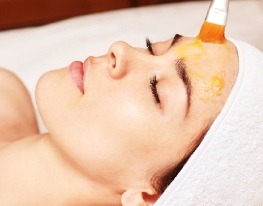About Us

Chemical Peeling
Chemical peeling is a technique used to improve the appearance of the skin, in terms of acne, marks, pigmentation and fine lines. It is typically performed on the face, neck, hands, feet, back or around the eyes. Chemical peel uses a chemical solution to improve and smooth the texture of the facial skin by removing its damaged outer layers. It causes the skin to separate, flake off and allows new skin to regenerate.
Chemical peeling has been performed and perfected over the last 50 years. In fact, “home chemical peels” have been used for hundreds of years, where women have applied crushed tomatoes and sour milk to their face to brighten the skin. Cleopatra bathed in goat’s milk and French women in the 17th century scrapped off crushed grapes from the bottom of wine barrels, and washed their face with it. These are all variations of milder chemical peels using fruit acids and lactic acid.
In fact, most chemical peels are made from natural ingredients. Glycolic acid peels are derived from sugarcane, Kojic acid peels come from wild mushrooms, lactic acid peel is made from sour milk, arbutin peels are derived from berries.. and so much more! It is a time – tested method for rejuvenation and restoring the skin to its original youthful appearance.
It is helpful for those individuals with facial blemishes, wrinkles, under-eye dark circles, sun-damaged skin and uneven skin pigmentation. Chemical peels can also treat acne, post-acne pigmentation and scarring, as well as remove pre-cancerous growths. The precise formula used may be adjusted to meet each patient’s needs. The new skin is temporarily more sensitive to the sun.
Our facility offers a range of over 15 different types of peels for the treatment of various skin disorders. Chemical peeling may be combined with laser resurfacing, dermabrasion, dermarollers, soft tissue fillers and cosmeceutical preparations to achieve cost-effective skin rejuvenation customized to the needs of the individual patient. If you have a history of herpes (cold sores), you should inform your physician prior to the procedure.
Chemical peeling is a simple office procedure, which requires no anesthesia, takes only a few minutes and has a very minimal down-time (recovery time). Prior to peeling, instructions may include the elimination of certain medications/creams and preparing your skin with ‘pre-conditioning’ creams. At the time of treatment, the skin is thoroughly cleansed with an agent that removes excess oils, and the eyes, ears and hair are protected.
One or more chemical solutions are used. Cosmetic dermatologists are qualified to select the proper peeling agent based upon the type of skin damage present. During a chemical peel, the dermatologist applies the solution either to entire face/back or to select areas, to produce a controlled wound, enabling new, refreshed skin to appear. Most patients experience tingling, and a warm to somewhat hot sensation which lasts about five to ten minutes. At the end of the peel, a neutralizing solution is sprayed to the area and washed off with cold water.
Chemical peels can significantly fade pigmentation but may not always make them disappear. They cannot tighten lax skin or treat deep scarring. They may not bring about appreciable change in the pore size. They do not remedy facial redness or broken vessels.
Superficial peels are virtually safe in all skin types, and there are no long-term side-effects. Depending upon the type of peel, a reaction similar to a sunburn occurs following a chemical peel. This usually involves redness, followed by scaling that ends within one to five days. It is important to avoid overexposure to the sun after a chemical peel since the rejuvenated skin is fragile and more susceptible to complications. Your dermatologist will prescribe the proper follow-up care to reduce the tendency to flake after peeling. Given the nature of the procedure, patients generally need multiple treatments on a fortnightly or monthly basis to reach a desired result. This in essence, implies a program of care coordinated by the doctor and the patient. The number of peels carried out ranges from 3 to 15 depending on the condition being treated.

